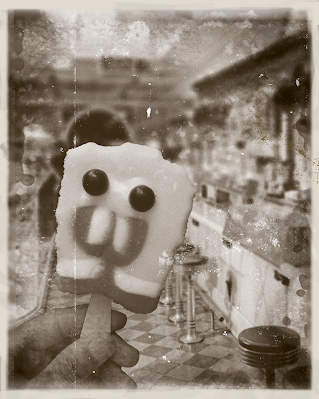Adrienne Ray- Old is New Again
I wanted to make something that related to the nineteenth century and my childhood. The parlor background came from the Library of Congress. It relates because ice cream parlors gained popularity in this century with the development of industrial refrigeration. I chose the subject based on my love of ice cream and other sugary foods. Even though cartoons hadn't been invented yet, I thought it would be humorous to photograph this SpongeBob popsicle. I used textures from creative cloud, blur effects, noise and my own watercolor texture to edit.


This unique amalgamation serves as an exploration of cultural and temporal intersections. The artist's choice to photoshop a SpongeBob ice cream bar into an 1800s ice cream parlor hints at a playful commentary on the timeless appeal of cultural symbols. The cartoon ice cream bars with mismatched gumball eyes were a staple of our childhoods. The eyes would never look right, either crooked or seriously slouching down the bar. They would come in a variety of characters, Dora the explorer and Sonic the Hedgehog being among the options. The deliberate anachronism sparks reflection on the nature of childhood delights, transcending historical confines, everyone loves a sweet treat. The treatment of textures and scratches on the image takes on the metaphorical significance of being a forgotten but timeless event in our childhoods. The intentional imperfections could symbolize the passage of time, suggesting that even in the charm of nostalgia, there are cracks and scratches that become part of the memory.
ReplyDeleteIn assessing both content and technique, the photograph excels in its ability to seamlessly integrate the incongruent elements. The artist adeptly utilizes the Wet-Plate Collodion Process, employing shallow depth of field to focus on the SpongeBob gumball bar while capturing the essence of the immobile historical setting. The 4:3 aspect ratio aligns with the traditional wet-plate era, adding authenticity composition. The deliberate introduction of scratches from the glass plates, runs in the emulsion, and other wet elements enhances the overall aesthetic. The choice of black and white monochromatic imagery, coupled with sepia prints, heightens the vintage feel.
Furthermore, the incorporation of the hand in the left corner serves as a subtle yet impactful addition. It not only adds a touch of whimsy but also reinforces the playful commentary on the intersection of the past and present. This element introduces a human touch, connecting the viewer to the scene and highlighting the universal experience of enjoying ice cream across different eras.
In summary, this wet colloidal Photoshop composite is a captivating example of cultural intersections and historical play. The artist skillfully employs the Wet-Plate Collodion Process, not only to support the historical context but also to enhance the narrative depth. The intentional blend of photographic elements and metaphorical treatment elevates the work beyond mere visual juxtaposition. This photograph stands as a testament to the artist's ingenuity in seamlessly fusing images, creating a narrative that sparks contemplation on the charm of cultural symbols across time.